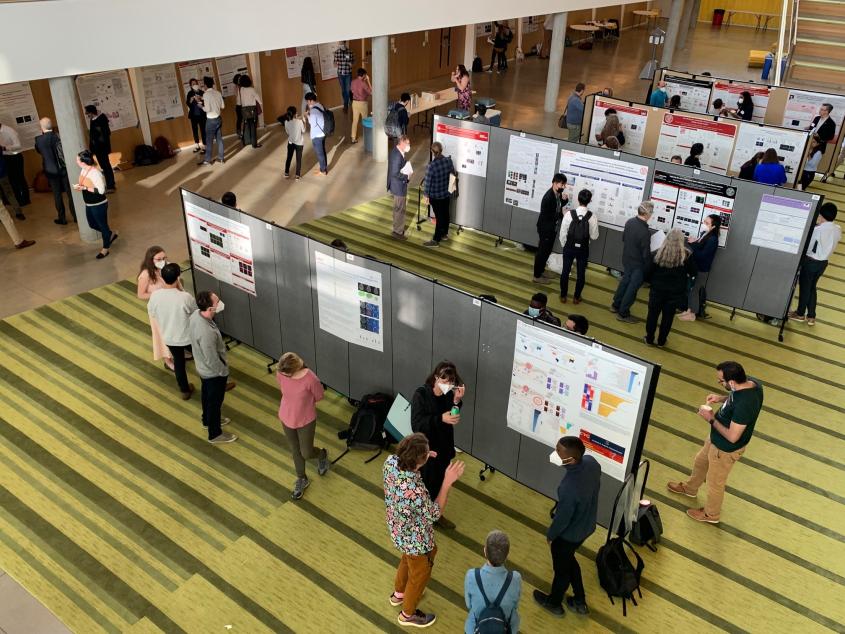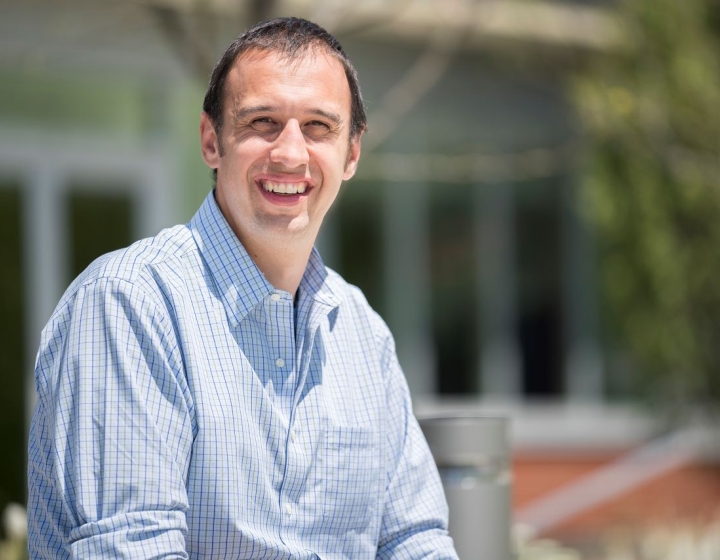Cancer symposium fosters collaboration across Cornell
On May 19 and 20, researchers from Cornell University’s Ithaca and New York City campuses gathered at the Cornell College of Veterinary Medicine (CVM) for the third Intercampus Cancer Research Symposium.
Returning after a two-year, pandemic-related hiatus, the annual event showcased the wide range of cancer research taking place at Cornell and allowed faculty and trainees (graduate students and postdocs) to identify potential areas for collaboration. Among the 170 registrants, about 50 attended from New York City, more than doubling their number from previous years.
Collaboration is key
“Cancer research at Cornell is truly multidisciplinary and a prime example for how collaborations across disciplines can advance insights not possible with conventional approaches,” said Dr. Claudia Fischbach-Teschl, the Stanley Bryer 1946 Professor of Biomedical Engineering in the Nancy E. and Peter C. Meinig School of Biomedical Engineering and co-director of the Cornell Center on the Physics of Cancer Metabolism. “While cancer researchers at Weill Cornell Medicine in New York are centrally affiliated through the Meyer Cancer Center, investigators in Ithaca are located across different departments and colleges. Our goal for the symposia is to provide a venue that catalyzes new collaborations between researchers on the Ithaca campus as well as with investigators and clinicians in New York.”
The Meyer Cancer Center served as a key organizer and funder of the event. “Collaboration is at the heart of the Meyer Cancer Center,” said Dr. Kristy Brown, an associate professor of biochemistry in medicine and a member of the Meyer Cancer Center at Weill Cornell Medicine. “Our members include basic and clinical researchers, and we work together to translate research from bench to bedside and back again – striving to make advances for our patients and our community. Many of us have had close ties with investigators in Ithaca, allowing us to push our science further and foster multidisciplinary efforts. It was wonderful to help organize this meeting as it was an opportunity to meet again in person and introduce our colleagues to the strengths across our various institutions and departments. We hope to continue building these collaborations to change medicine for the better.”
Co-organizer Dr. Robert Weiss, CVM associate dean for research and graduate education professor of molecular genetics in the department of biomedical sciences, and director of the Comparative Cancer Biology Program, credits Cornell’s Academic Integration initiative with providing the financial backing to make more regular events possible since 2018. “This relates to the recognition that each campus has its own strengths, but there is also a lot of overlap, so bringing people together to share their recent findings is really fruitful,” he said.
Weiss cites work in cancer immunotherapy – how the immune system impacts tumor development and response to therapy – and an emphasis on patients and translational research as areas of focus at Weill Cornell Medicine. The Ithaca campus brings expertise in basic sciences – particularly engineering and physical sciences, including chemistry – as well as nutrition, veterinary medicine, and animal models to the table. Within engineering, Fischbach highlights data science, imaging, and microfabricated model systems. “Those are unique to our campus,” she said.
A rich program
During four sessions, Cornell speakers from both campuses touched on topics across this spectrum, discussing perspectives on immunotherapy, nutrition, model systems, and cell and molecular biology in relation to cancer. Two distinguished visiting keynote speakers further enriched the program. The first, Dr. Sheila Stewart, the Gerty T. Cori Professor of Cell Biology and Physiology at the Washington University School of Medicine, gave a talk with the title “The stromal compartment plays a pivotal role in tumor progression.” On the second day, Darrell Irvine, professor of biological engineering and materials science and engineering at MIT, spoke about “Controlling timing and location of IO drugs for safe and effective cancer immunotherapy.”
The faculty dinner at the Statler Hotel brought some levity into the proceedings when Mike Fontaine, a professor in the department of classics, talked about the ancient art of humor. “It was a big hit,” Weiss said. “It was a nice way that we in Ithaca could share our strengths beyond sciences, in humanities and arts.”
Improving cancer science
Four lunchtime working groups also addressed opportunities and challenges within and beyond the science of cancer. While one group discussed the core facilities – such as the Biotechnology Resource Center or the Cornell NanoScale Science and Technology Facility – available at each campus, another explored how best to incentivize researchers to get involved with collaborative grants and what support the university can provide. In the other groups, participants from the Ithaca campus, in particular, had much experience to share on the topic of career development and diversity and inclusion. “It’s not only about the people we recruit to do cancer research or helping diverse undergraduates get access to labs, but also how we make the research more equitable in terms of patient samples and looking at the right cohorts,” Fischbach said. “And our trainees were really terrific in providing insights on how they would benefit from different mentoring opportunities.”

As the poster session with nearly 50 entries (and Cornell Dairy ice cream) showed, some of the most powerful lessons can come from off-campus teachers. “Community engagement is one of our strengths in Ithaca,” Weiss explained, referring to the Cornell Cancer Partnership, a program that – under primary community liaison Bob Riter – connects researchers-in-training with patients and survivors. Some of these community members served as judges, selecting the winning posters based on how well they communicated science to a non-expert audience. “For one of my students who won a poster prize, that was the most impactful part of the meeting,” Weiss said. “The trainees could see how their research affects people, and not just clinically.”
Poised for breakthroughs
Overall, Weiss summarized, “there were a lot of cutting-edge ideas, and enthusiasm was running high” at the symposium. On the research front, for example, he sees investigators moving beyond traditional silos to collaborate at the intersection of their fields. “I think we saw more of these intersections at this meeting than we had in the past,” he said. “That’s really exciting, because that’s where the big breakthroughs come.”
Organizers and attendees were in agreement that a formal, campus-wide cancer program in Ithaca would be helpful in keeping these collaborations going. “Fostering them really requires regular interaction and commitment,” Fischbach said. “Having a constant, solidified basis would help increase those efforts in the long run.” The symposia, she hopes, are only the beginning.
Written by Olivia Hall






